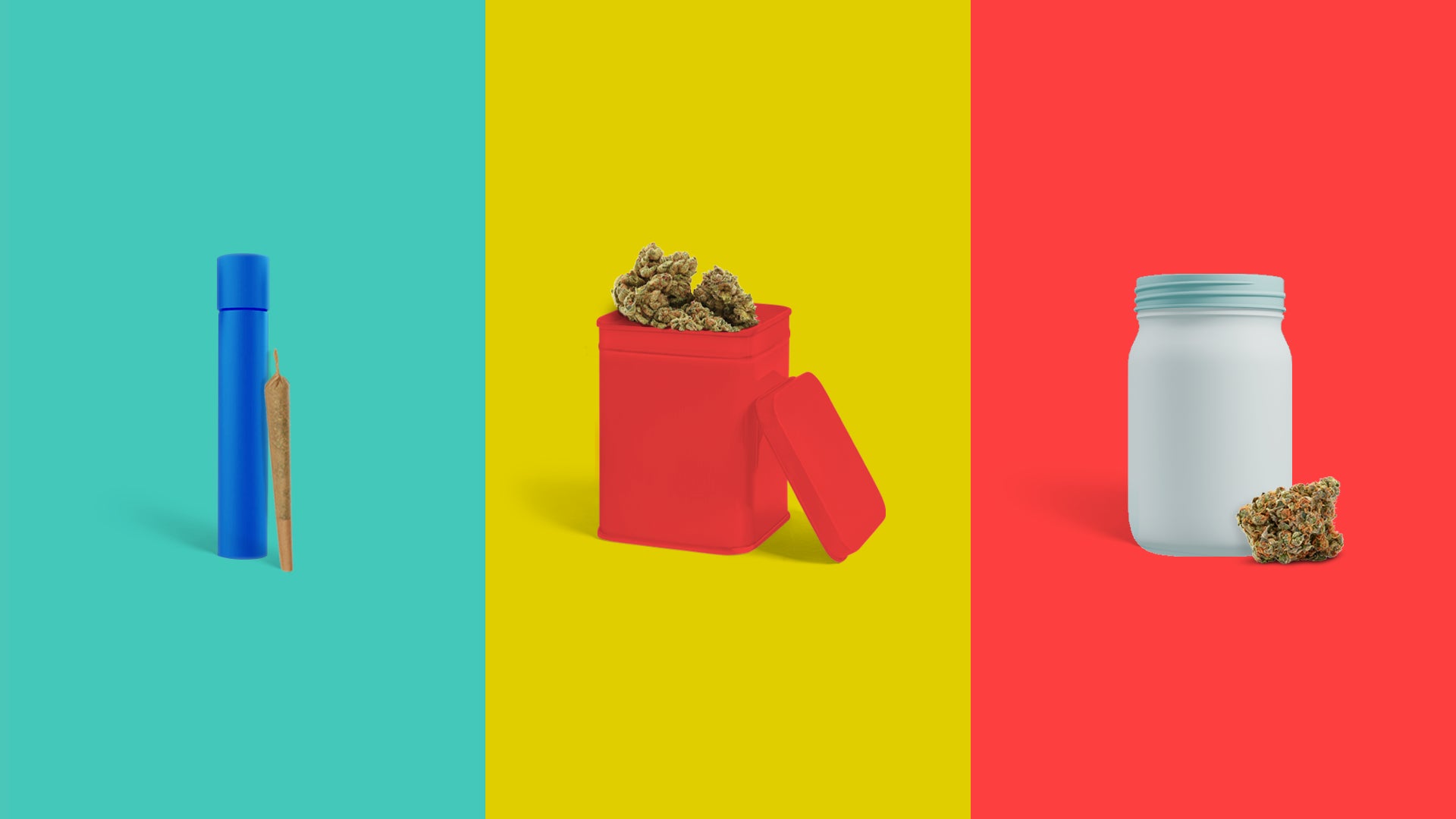
Sure, there are a lot of new cannabis formats now, but where would we be without flower? You know, the thing that started it all? Heck, we wouldn’t even HAVE all these new innovations to talk about if not for our favourite green plant. So let’s show our respect.
This ultimate guide to cannabis flower will set you up with a solid foundation before leaping off into other formats.
Table of contents
- Anatomy of a cannabis plant
- THC vs CBD
- The endocannabinoid system
- Indica vs sativa
- What the heck are terpenes?
- How to consume cannabis flower
- Consuming cannabis responsibly
Anatomy of a cannabis plant
“The green part,” “the tall part,” and “the leafy stuff” are all technically parts of a cannabis plant, but they actually have real names, too. In fact, there are many aspects of the cannabis plant that factor into the growth of the good, quality flower everyone is looking for.
Let’s learn about them, shall we?

Seeds
When it comes to cannabis seeds, there are three main types:
Regular seeds
- straight from nature
- nothing about them has been modified
- cannabis seeds in their birthday suits
Feminized seeds
- influenced by breeders to be female
- girl power
Autoflower seeds
- specifically bred to make plants that flower on their own schedule
- they rely on no one (well, except growers)
Cotyledons
Think of cotyledons as a prequel to a movie. They’re these tiny leaflets that sprout from a plant as its germination stage begins. Cotyledons start and maintain photosynthesis while the true, serrated leaves grow. They’re kind of like an opening act—still very important, but the main attraction has yet to come.
Roots
Depending on how it was grown, a cannabis plant might have different kinds of roots. If it was grown from a seed, the plant will have a large taproot and a lot of smaller feeder roots. If it was grown from a clone then there won’t be a taproot, just the feeder roots. In addition to anchoring and supporting the plant in the soil, roots also draw in, store, and distribute nutrients. To sum up: roots are important.
Stalk and stems
The stalk of a cannabis plant is the main stem that the other, smaller stems and branches sprout from. The stalk is there for support, while the smaller stems and branches are there to hold up the leaves and flower to make sure they’re getting enough light. Teamwork makes the dreamwork, or in this case, makes the cannabis plant grow properly.
Leaves
If plants were people, leaves would be the lungs. But plants are not people, so the leaves are just...leaves. They take in carbon dioxide, expelling water and oxygen. Plus, they turn light into energy which helps the plant grow. This process is also known as photosynthesis, which is hard to spell.
Cuttings
When a mother plant’s branches are pruned, the snippets are called cuttings. That’s pretty straightforward. Those cuttings are then potted and begin to develop their own roots and, eventually, a whole new plant. That process is called cloning, and is objectively less straight-forward.
Pistil
Basically, when a mommy plant and a daddy plant really love each other...the pistil emerges from the female plant to collect the pollen from the male plant.
Stigma
On the pistil, you’ll find sticky hair-like fibres. They’re not there by accident. These are called stigmas, and their job is to capture as much pollen as possible. You catch more flies with honey, and you catch more pollen with stigmas.
Calyx
Once the female plants are pollinated by male plants, they form a tiny little seed. This seed is formed in the calyx of the female plant. It’s where the magic happens, or at least where it starts.
THC vs CBD
THC and CBD are the most researched and well-understood active compounds in cannabis, and quite frankly they’re two of our favourites.
THC stands for delta-9-tetrahydrocannabinol. It’s responsible for many of the feelings people experience when they’ve consumed cannabis. In other words, it’s the reason people get “high” off cannabis. CBD, or cannabidiol, is gaining more and more interest because it doesn’t produce the same intoxicating effects as THC. You may not feel the same “high” from CBD as you would from THC, but it does still have an effect on the brain, so you might feel a little “different.”
See, THC binds to the CB1 receptors in your endocannabinoid system (more about this later), which is what gives you those intoxicating effects. However, CBD doesn’t bind well to your CB1 or CB2 receptors, which is why it doesn’t cause the same reaction.
But just because THC and CBD react differently in your body doesn’t mean they’re totally independent from each other. In fact, if you consume a cannabis strain with both THC and CBD in it, the CBD can actually act as a buffer against some of the effects of THC. This is why Health Canada recommends that recreational consumers “choose products with low amounts of THC and equal or higher amount of CBD.” These products or strains fall into two different categories: balanced or 1:1, and CBD-dominant.
Oh, and no—this doesn’t mean that you can take a bunch of CBD to help out if you think you’ve consumed too much THC. In order for CBD to act as a buffer, they need to be consumed together, like peanut butter and jelly or mac and cheese.
The endocannabinoid system
Remember how we said we’d get to more about this later? It’s officially “later.”
We know our bodies react to cannabis; that’s pretty obvious. But not everyone knows why they react the way they do. You can thank the endocannabinoid system (or ECS) for that. The ECS is a biological system that interacts with the active chemical compounds of cannabis to create the effect you feel after consuming.
Think of it as a lock-and-key system. The ECS has receptors spread throughout your entire body, and in order for cannabis to make you feel something, it needs to interact with these receptors. The receptors are like the lock, and cannabinoids are like the key. Put them together and you get access to the different effects cannabis can provide—kind of like a backstage pass to your own body.
We went over this earlier, but let’s talk about it again (because it’s fun). THC binds to the CB1 receptors in your ECS, which is what creates the intoxicating effects you feel, or what gets you high. CBD, on the other hand, doesn’t bind well to the CB1 or CB2 receptors, so that’s why you don’t feel the same effects that you would from THC.
In simpler terms, endocannabinoid system = good. We like it.
Indica vs. sativa
Before we get too far into this topic, you should keep this in mind: though some people use the terms “indica” and “sativa” to classify different strains of cannabis, there’s no hard-and-fast evidence to back up any of the claims people make.
Got it? Okay. Now let’s take a look at where these words came from.
Orgins
In 1753 (no, that’s not a typo...it was that long ago), Swedish scientist Carl Linnaeus declared there to be only one species of cannabis, which he classified as cannabis sativa. Linneaus, bless his heart, was wrong. Let’s not dwell on the past, though. We’ve all made mistakes.
Linnaeus got to bask in the glory of being right for a few decades, until French scientist Jean-Baptiste Lamrack suggested there were actually two species of cannabis: cannabis sativa, which was cultivated in Western Continent, and cannabis indica, which was a wild species growing in India and its surrounding countries1.
That’s great. What does any of this have to do with my weed?
We’re getting to that, we promise.
See, some people use the terms indica and sativa to classify types of weed, specifically how they might make you feel. Like we said at the beginning...these claims aren’t scientifically proven. But, for the sake of learning, let’s go through them both.
Indica
There are people who use the term “indica” to describe strains that are more sedating or physical in nature. You might have even heard people say “in da couch” when referencing an indica strain. That’s because the effects might leave you wanting to stay in one spot until they wear off.
Sativa
To some people, sativa strains provide more energizing or cerebral effects. Unfortunately there’s no cheeky saying to remember what sativa means, but as long as you know that indica could leave you “in da couch,” try to remember that sativa will...probably not do that.
Again, and we cannot stress this enough, strains classified as indica and sativa are all based on anecdotal information. The only hard facts in this section are the names of those scientists and that some people like to do some things.
What the heck are terpenes?
Terpenes are these teeny tiny organic molecules found in every strain of cannabis, and they’re responsible for the flavours and aromas you might experience. Each strain has a different combination of terpenes, and no two strains are alike—kind of like snowflakes, fingerprints, or relationships with your parents.
These are the terpenes we like to focus on the most...so you should, too.*
*Yikes, that was a bit aggressive. We shouldn’t be telling you what to do. But if you wanted to focus on certain terpenes, these would be the ones.
The world is filled with mystery. Think about it; whether you’ve been dreaming about outer space or simply trying to remember where you left your favourite tee, there are many topics out there that most of us simply don’t know enough about. Well, thanks to this page, we can now scratch “terpenes” off the list.

Beta-caryophyllene
[bey-tuh-carry-o-fy-lean]
Found in: clove, rosemary, hops, black pepper, oregano
Present in: Houndstooth, Argyle, Donegal, Highlands, Penelope
Fun fact: the only terpene that binds to cannabinoid receptors

Limonene
[lim-uh-neen]
Found in: peels of citrus fruits, pepper, cloves, hops, basil, oregano
Present in: Argyle, Donegal, Penelope
Fun fact: is used as a food additive, as well as in cleaning agents

beta-Pinene
[bey-tuh-pahy-neen]
Found in: pine trees, spruce trees, black pepper
Present in: Penelope, Houndstooth
Fun fact: found together in plants with alpha-pinene, just in smaller amounts

Terpinolene
[tur-pine-o-lean]
Found in: allspice, nutmeg, tea tree, apples, cumin, juniper
Present in: Bakerstreet
Fun fact: referred to as a “lurker” terpene because it appears in many strains in small amounts

Humulene
[hu-mu-lean]
Found in: basil, safe, clove, hope
Present in: Argyle, Donegal, Highlands, Houndstooth
Fun fact: partially responsible for giving cannabis its distinct spicy, herbaceous, and subtly floral bouquet of aromas

Myrcene
[mer-seen]
Found in: mangoes, bay leaves, hops, lemongrass, wild thyme
Present in: Argyle, Bakerstreet, Donegal, Highlands, Houndstooth, Penelope
Fun fact: found in significant quantities in mangoes

Alpha-pinene
[al-fuh-pahy-neen]
Found in: coniferous trees, rosemary, basil, parsley, dill
Present in: Penelope, Highlands, Houndstooth, Donegal
Fun fact: what makes pine trees smell like pine

Linalool
[lin-uh-lool]
Found in: lavender, mint, cinnamon, coriander
Present in: Highlands, Argyle
Fun fact: found in over 200 essential oils
How to consume cannabis flower
Admittedly, there are a lot of ways to consume cannabis in general, but this is the ultimate guide to FLOWER, not the ultimate guide to everything else.
When it comes to consuming flower, there are two main ways to go. If you want to smoke your cannabis, you can do so with a joint, a pipe, or a bong. If you want to vape your dried cannabis, then a whole-flower vape is what you’ll need. Whether you smoke or vape your cannabis, it affects your body in the same way; the active compounds are absorbed into your bloodstream through your lungs almost immediately. This is why you’ll feel the effects of smoking or vaping within seconds or minutes.
So then why vape instead of smoke? When you vape dried cannabis, you’re just heating the product—not burning it. This releases the active components as vapour rather than smoke, which may minimize your exposure to combustion by-products that you could get from burning the cannabis.
Consuming cannabis responsibly
No matter how you choose to consume cannabis, it’s always important to stay responsible. Starting low and going slow is some of the best advice we can give you when consuming cannabis for the first time, or even if you’re just trying a new product.

New users
If you’re consuming cannabis for the first time, well then welcome. Glad to have you here. We can’t tell you what product to start out with, but we can tell you that Health Canada recommends consumers “look for a product containing 2.5 mg of THC or less or 10% THC (100 mg/g) or less, and an equal or higher amount of CBD.”
Onset times
If you’re smoking or vaping cannabis, the effects can take effect anywhere from seconds to minutes after you inhale it, and they can last up to six hours (or even as long as 24).
Carry limit
Canadians are legally allowed to carry 30 g of dried cannabis (or the equivalent in non-dried form). Of course, this is all subject to provincial or territorial regulations, so make sure you do the responsible thing and check regulations in your area.
Keep it locked up
It’s important to keep all cannabis in a safe, dry place. If you have pets or kids in the house, then make sure your cannabis is locked up and kept out of their reach.
Don’t drive high.
It’s not funny or cool. It’s illegal and dangerous. Do not drive high. Ever.
That’s all, folks.
There you have it. A not-so-basic rundown of everyone you need to know about flower. There’s no test or anything, but if you wanted to quiz yourself we wouldn’t stop you.
- Pollio A. The Name of Cannabis: A Short Guide for Nonbotanists. Cannabis
Cannabinoid Res 16 Oct. 2016, www.ncbi.nlm.nih.gov/pmc/articles/PMC5531363/



